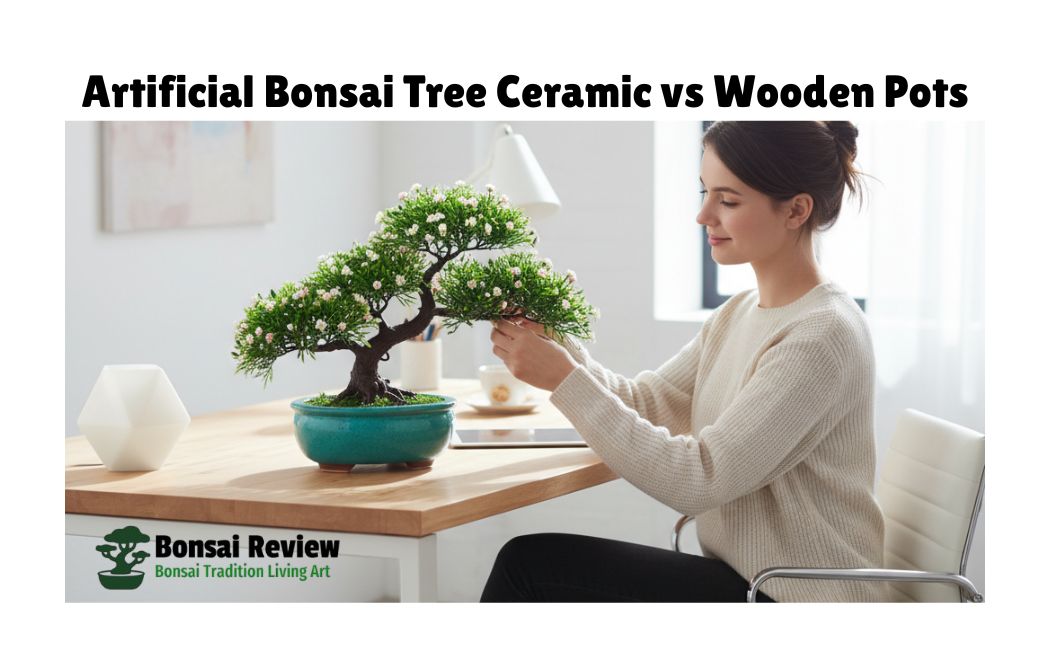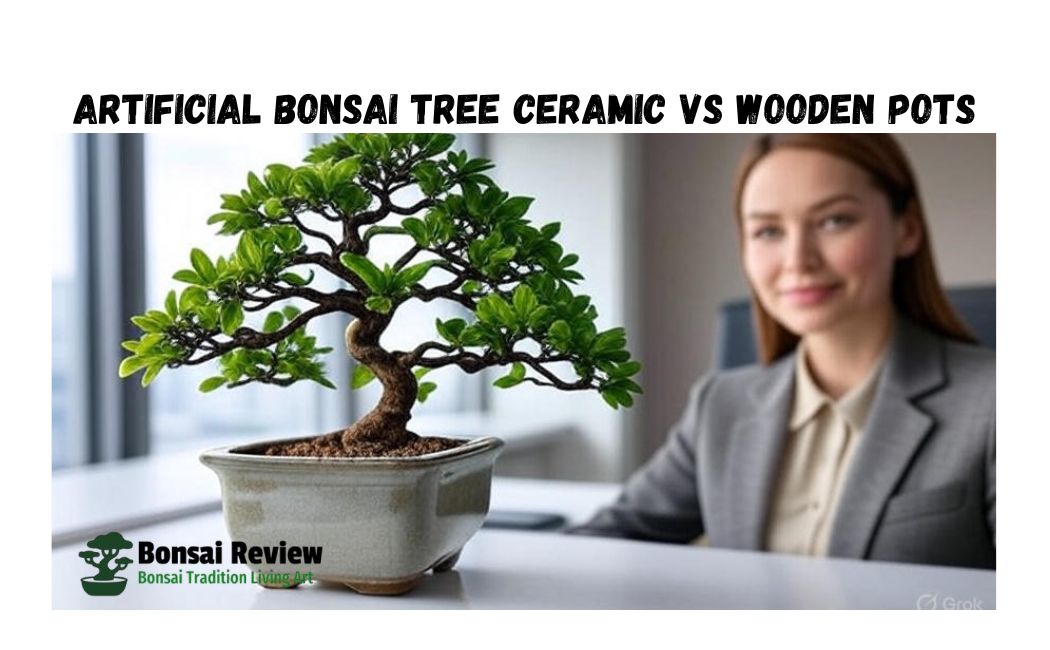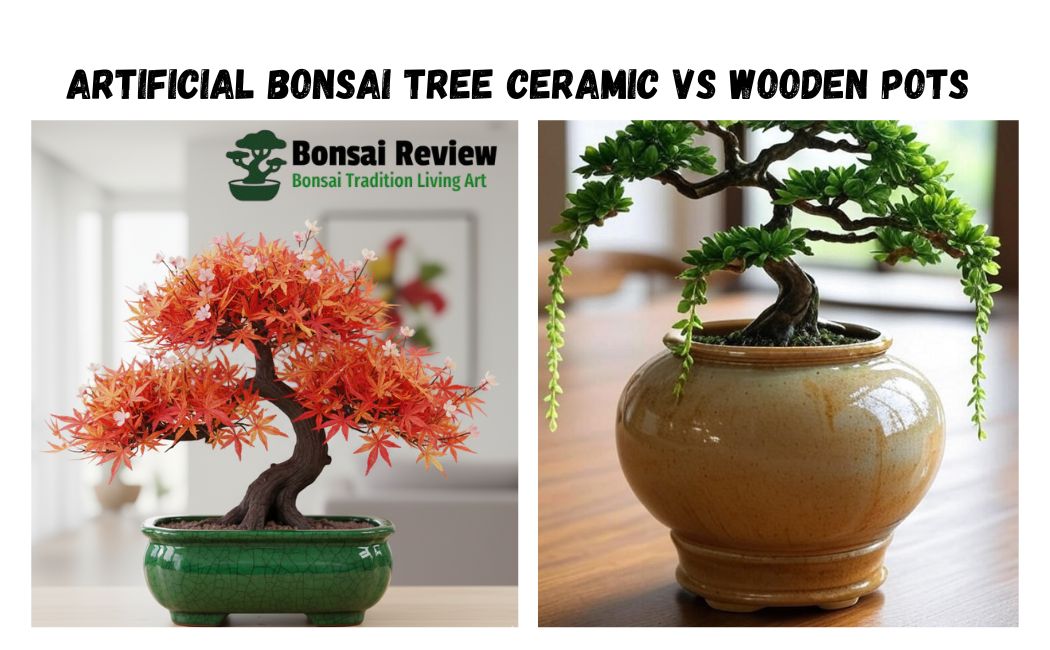Artificial bonsai tree ceramic vs wooden pots is a question many people face when trying to pick the right match for their indoor or outdoor home and office décor.
What does “bonsai” mean? The word “Bon-sai” is often misspelled as bonzai or banzai is a Japanese term that, literally translated, means “planted in a container”.
This art form is derived from an ancient Chinese horticultural practice, part of which was then redeveloped under the influence of Japanese Zen Buddhism.
For an artificial bonsai tree, the choice between a ceramic pot or a wooden pot depends on your desired aesthetic, durability, and budget.
Artificial bonsai tree ceramic vs wooden pots, traditional living art of bonsai, breathability, and moisture retention are not a concern.
So your decision is based purely on visual appeal and practicality. Ceramic containers offer a classic, durable, and refined look, while wood provides a warm, natural, and rustic feel.
Bought a faux bonsai from online platforms like Amazon or found a beautiful indoor bonsai at a store, and now you’re stuck between the elegance of ceramic bonsai pots and the rustic charm of wooden bonsai pots.
The unique pot you choose matters because traditional pots set the tone for your display. It’s a sleek Japanese bonsai pot for modern décor, a handmade ceramic pot for a refined centerpiece, or a DIY wooden bonsai pot for a natural, cozy look.
Unlike live bonsai, you don’t need to worry about air exchange, root health, or moisture. Instead, the choice comes down to style, durability, weight, and budget.
You’ll see a clear comparison between ceramic and wooden options so you can pick the one that feels right for your space, if it’s a gift, a home accent, or an artificial bonsai display for your office desk.

Why Pot Choice Still Matters for Artificial Bonsai Decor?
You may think a pot doesn’t matter for a faux bonsai, since there are no roots, soil, or water to worry about. But the truth is, the pot is just as important for an artificial bonsai tree as it is for a real one.
The container sets the tone for the whole display. A ceramic bonsai pot can bring elegance and refinement, while a wooden bonsai pot adds warmth and rustic charm.
Think about where you’ll place the artificial bonsai tree ceramic vs wooden pots. On an office desk, a polished Japanese bonsai pot or modern glazed ceramic design makes your workspace feel calm and professional.
In a cozy living room, a DIY wooden bonsai container or forest-style rustic pot creates a natural, grounded look.
Even though you don’t need to worry about air exchange, root-bound bonsai problems, or dried overwatered soil, the pot still decides how realistic and stylish your indoor bonsai décor feels.
Artificial Bonsai Tree Ceramic vs Wooden Pots: Which One Should You Choose?
When you search for artificial bonsai tree ceramic vs wooden pots, you’re really asking: “Which pot gives me the right look, durability, and fit for my space?”
Both ceramic and wooden bonsai pots come with their own style, feel, and benefits, but the choice depends on your needs.
A ceramic pot is best if you want a sleek, polished look that highlights the bonsai’s details. It offers more durability, is easy to clean, and often feels more traditional in bonsai display.
On the other hand, a wooden pot gives a natural, rustic vibe that blends well with warm interiors. It’s usually lighter, easier to move, and often more affordable. When you pick between the two, think about:
- Durability: Ceramic lasts longer but can chip if dropped.
- Weight: Wood is lighter, ceramic is heavier and more stable.
- Moisture: Ceramic locks in moisture better, while wood may dry out faster.
- Style: Ceramic feels formal and refined; wood feels cozy and earthy.
By matching the pot to your bonsai and home décor, you not only solve the style problem but also make your plant easier to maintain.

Ceramic vs Wooden Bonsai Pots Side-by-Side.
Artificial bonsai tree, ceramic vs wooden pots, which is best? Ceramic pots are more durable, offer better aesthetics with a wider variety of designs, and provide good moisture and air circulation for bonsai trees.
While wooden pots offer a natural charm and can help regulate temperature, but eventually break down over time, requiring more maintenance.
The choice ultimately depends on aesthetic preference and the tree’s species and environment, with ceramic pots being a popular and long-lasting choice, especially for glazed finishes.
| Feature | Ceramic Pot | Wooden Pot |
| Look & Style | Sleek, elegant, refined, works for modern & Japanese bonsai décor | Natural, rustic, warm, blends with forest-style or cozy interiors |
| Durability | Very durable, long-lasting, resistant to wear | Can wear over time, may warp or crack if exposed to moisture |
| Weight & Stability | Heavy, provides stability for top-heavy artificial bonsai | Lightweight, easy to move, less stable for heavy trees |
| Maintenance | Easy to clean, non-porous surface | Needs occasional care to protect wood, may require polish or finish |
| Cost | Generally higher, premium décor option | Often more affordable, DIY-friendly |
| Best For | Indoor décor, office desk, gifting, delicate or premium artificial bonsai | Rustic home décor, DIY setups, large or casual artificial bonsai displays |
| Popularity | Widely preferred for formal displays | Popular for natural, traditional, or handcrafted décor |
| Material Variants | Glazed, unglazed, handmade, antique, Japanese bonsai pots | Hardwood, reclaimed wood, forest-style, DIY wooden bonsai containers |

Why Choose Ceramic Pots for Your Artificial Bonsai?
When you’re deciding between pots, you might wonder: “What makes ceramic bonsai pots the best choice for my artificial bonsai tree?” Ceramic pots have been a classic choice for centuries, and for good reason.
Artificial bonsai tree ceramic vs wooden pots offer a polished, elegant look that instantly elevates any indoor décor or office display. A Japanese bonsai pot or handmade glazed ceramic adds sophistication, making your faux bonsai appear more like a real, artistic centerpiece.
Ceramic pots are also durable and long-lasting. Unlike wood, they don’t warp, fade, or wear down over time, which is ideal for heavier artificial bonsai trees that need stability. Their weight provides balance, preventing your tree from tipping over, especially if it has a dense canopy or artificial flowers.
Another benefit is ease of maintenance. The smooth, non-porous surface of glazed ceramic makes it simple to wipe clean, keeping your bonsai display dust-free and vibrant.
Plus, ceramic comes in many styles, colors, and finishes, from antique-inspired designs to modern minimalist pots. So you can match your tree to any home or office aesthetic.
Overall, artificial bonsai tree ceramic vs wooden pots. If your goal is to create a premium, refined look for your artificial bonsai tree, a ceramic pot is a safe and stylish choice.
Why Wooden Pots Can Be the Perfect Choice for Your Artificial Bonsai?
You might ask yourself: “Why would I pick a wooden bonsai pot over a ceramic one for my artificial bonsai tree?” Wooden pots bring a natural, rustic charm that instantly adds warmth to any space.
If you’re creating a forest-style display, a cozy corner in your home, or a casual office desk setup, wooden bonsai pots make your artificial bonsai feel more connected to nature.
One of the main advantages is lightweight versatility. Wooden pots are easier to move than ceramic ones, making them perfect if you plan to reposition your bonsai or change your décor regularly.
Artificial bonsai tree ceramic vs wooden pots also provide a traditional, handcrafted aesthetic that pairs beautifully with DIY wooden bonsai containers or forest-style faux bonsai.
Wooden pots require a bit more attention than ceramic ones. Exposure to moisture can cause warping over time, so it’s best to keep them dry and occasionally polish or treat the wood.
Despite this, the organic vibe and cozy feel often outweigh these minor maintenance needs, especially for larger artificial bonsai or setups where a rustic, natural look is desired.
In short, if you want your artificial bonsai tree to radiate warmth, earthy charm, and a handcrafted appearance, a wooden bonsai pot is an excellent option.

Which Pot Should You Choose for Your Artificial Bonsai?
After exploring the differences between ceramic and wooden bonsai pots, you might still wonder: “Which one is right for me?” The answer depends on your style preference, space, and how you plan to display your artificial bonsai tree.
If you want a refined, polished look that works well in modern interiors, office desks, or as a gift, a ceramic bonsai pot is your best choice.
Its durability, weight, and elegant finishes make it ideal for a premium, long-lasting display. Choose a Japanese bonsai pot, a handmade glazed ceramic, or an antique-inspired design to highlight your faux bonsai’s beauty.
On the other hand, if you’re going for a cozy, rustic, or natural aesthetic, a wooden bonsai pot fits perfectly. Lightweight and often DIY-friendly, wooden pots complement forest-style artificial bonsai, large indoor displays, or casual spaces. Their warm, earthy charm creates a more relaxed atmosphere that pairs well with rustic décor.
Artificial bonsai tree ceramic vs wooden pots, both options can enhance your indoor décor and make your artificial bonsai tree a stunning centerpiece. The key is to match the pot with your space, personal taste, and display goals, so you get the look and feel you want without worrying about maintenance.
Conclusion: Making the Right Choice for Your Artificial Bonsai Tree
Choosing between ceramic and wooden bonsai pots doesn’t have to be difficult. Both options have unique benefits that can enhance your artificial bonsai tree and your indoor décor.
If you prefer a sleek, elegant, and durable look, ceramic bonsai pots are the ideal choice. Artificial bonsai tree ceramic vs wooden pots bring stability, longevity, and a refined aesthetic that works beautifully for office desks, living rooms, or gifting.
If you want a warm, rustic, and natural vibe, wooden bonsai pots offer charm, versatility, and a handcrafted feel that complements forest-style displays or cozy interiors. They’re also lightweight and DIY-friendly, making them perfect for casual arrangements.
Ultimately, the best choice depends on your style preference, budget, and display goals. By understanding the differences and weighing the pros and cons, you can confidently select a pot that makes your artificial bonsai tree a stunning centerpiece in any space.
Most relevant article: Does an Artificial Bonsai Tree Bring Luck or Just Style to Your Home?
FAQs: Artificial Bonsai Tree Ceramic VS Wooden Pots Best for Indoor Decor.
1. Are ceramic pots good for artificial bonsai?
Yes! Ceramic bonsai pots are highly durable, stable, and visually elegant. They work well for indoor décor, office displays, or as a premium gift. Their smooth surface makes them easy to clean, and they complement both Japanese and modern faux bonsai.
2. Are wooden pots suitable for artificial bonsai?
Absolutely. Wooden bonsai pots add warmth and a natural, rustic look. They’re lightweight, easy to move, and perfect for forest-style or large artificial bonsai displays. Some care is needed to prevent warping, but they offer a cozy, handcrafted vibe.
3. What is the cheapest alternative to bonsai pots?
If you want a budget-friendly option, consider DIY bonsai pots, plastic pots, or recycled containers. These are perfect for casual displays or for experimenting with different styles without investing in expensive ceramic or wooden pots.
4. Which looks more realistic for artificial bonsai: ceramic or wooden?
Artificial bonsai tree ceramic vs wooden pots depends on your style preference. Ceramic pots create a refined, classic look that highlights the tree’s details, while wooden pots provide a natural, earthy appearance that complements rustic décor and forest-style setups.
5. Can I use artificial flowers with my bonsai in ceramic or wooden pots?
Yes! Both ceramic and wooden bonsai pots are great for arranging artificial flowers or faux bonsai foliage, helping you create a vibrant, decorative display with minimal maintenance.
6. Do plants do better in plastic or ceramic pots?
Glazed ceramic pots have airflow and do not dry out as rapidly. Plastic pots do not facilitate air circulation and retain moisture longer than glazed pots. Plastic containers work best for houseplants that require moisture and for people who tend to forget to water them.
7. Should bonsai pots be glazed?
Glazed pots are perfectly suited for flowering trees, as they have a glossy appearance and smooth texture, elevating the overall aesthetic appeal of your bonsai. The size, design, and gender are the crucial factors to consider while choosing pots for your bonsai.
8. Are black pots bad for plants?
Researchers have found that containers in darker colors, especially black, heat the soil more. For example, in one study, researchers grew bush beans in black, white, and silver containers. Soil temperatures on the sun-facing sides of the containers were highest in the black pots and lowest in the white pots.